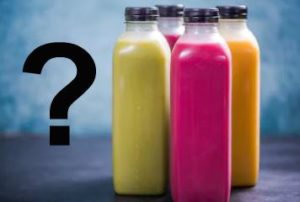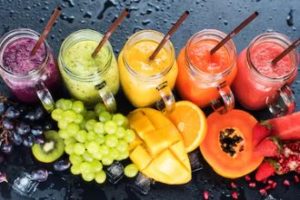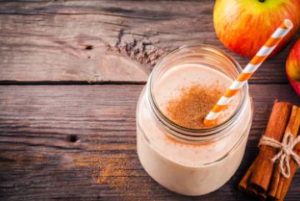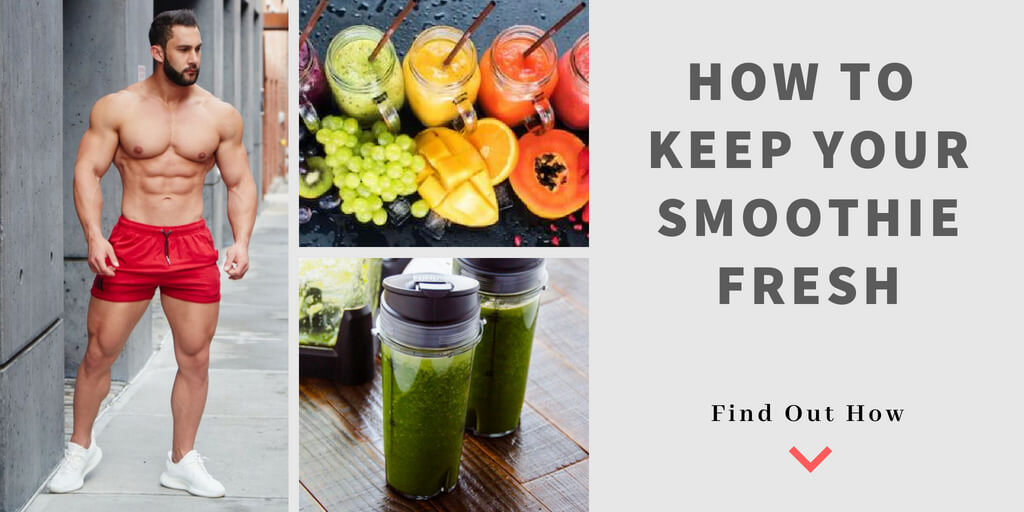As you walk up to the brightly colored sign, hear the whirring sound of blenders, and see the happy, smiling faces passing by sipping on their straws, you may be looking forward to having a fresh, chilled smoothie of your own.
But, do you really know what it’s in your smoothie?
 With the wide array of fresh fruit near the counter, you may be fooled into thinking that your smoothie or fresh-squeezed juice blends are good for you. However, some smoothies you get over the counter can contain around 160-280 calories and 34-38 grams of sugar per 8 ounces
With the wide array of fresh fruit near the counter, you may be fooled into thinking that your smoothie or fresh-squeezed juice blends are good for you. However, some smoothies you get over the counter can contain around 160-280 calories and 34-38 grams of sugar per 8 ounces
And this is only half of what is in an average 16-ounce smoothie. Therefore, you could be drinking about 20 packets worth of sugar. And as for blended juice drinks you find in the grocery store, some brands can have around 50 grams of sugar, or the equivalent of around 12 teaspoons of sugar in a 15-ounce bottle, which is equal to a 20-ounce bottle of regular cola. And to top it off, such “healthy” juice blends have little to no fiber or protein in them.
Where is all this sugar coming from?
 Juices, sugar syrups, and refined sugar are just some of the forms of sugar in your smoothie. The fruit sugar from fresh fruit is not necessarily a bad thing since fruit also contains fiber, potassium, and antioxidants like vitamins A, C, and E, to name a few. However, you will want to make sure that the fruit sugar, or fructose, in your smoothie or blended drink is mostly from fresh fruit, not juices or syrups, so you can benefit from the bulk of the fiber in the pulp of the fruit.
Juices, sugar syrups, and refined sugar are just some of the forms of sugar in your smoothie. The fruit sugar from fresh fruit is not necessarily a bad thing since fruit also contains fiber, potassium, and antioxidants like vitamins A, C, and E, to name a few. However, you will want to make sure that the fruit sugar, or fructose, in your smoothie or blended drink is mostly from fresh fruit, not juices or syrups, so you can benefit from the bulk of the fiber in the pulp of the fruit.
On the other hand, added sugars such as those from some juices, sugar syrups, and other forms of sugar such as corn sweetener, high fructose corn syrup, invert sugar, malt sugar, molasses, or even honey, to name a few, can have negative health effects if consumed in excess. It is recommended that most women should consume no more than 6 teaspoons of added sugars a day, and most men should consume no more than 9 teaspoons a day. Any more than this, over time, can increase risk of chronic diseases such as obesity, heart disease, type 2 diabetes, not to mention dental health.
How can I make my smoothie healthy?
Whether you are getting your smoothie from a shop, supermarket, or making it at home yourself, there are a few guidelines you should remember to ensure that you are truly drinking a nutritious smoothie and not just a glorified sugary beverage.
Focus on fresh fruit…and vegetables
 Sweeten your smoothie naturally with fruit instead of added sugars. However, don’t forget to add in some vegetables like leafy green kale and baby spinach, cucumbers, carrots, and beets to balance out your beverage and add some extra fiber without adding a whole lot more carbohydrates. Fiber is not digested in the body, so can keep you fuller longer, sustain energy, help your body absorb more nutrients from the foods you eat, and helps stabilize blood glucose levels. And when you are adding in fruit, choose lower sugar options like strawberries, raspberries, blueberries, cranberries, cantaloupe, watermelon, honeydew melon, and avocado, which are all less than 10 grams of carbohydrate per ½ cup serving. Limit high sugar fruit such as bananas, pineapple, and grapes.
Sweeten your smoothie naturally with fruit instead of added sugars. However, don’t forget to add in some vegetables like leafy green kale and baby spinach, cucumbers, carrots, and beets to balance out your beverage and add some extra fiber without adding a whole lot more carbohydrates. Fiber is not digested in the body, so can keep you fuller longer, sustain energy, help your body absorb more nutrients from the foods you eat, and helps stabilize blood glucose levels. And when you are adding in fruit, choose lower sugar options like strawberries, raspberries, blueberries, cranberries, cantaloupe, watermelon, honeydew melon, and avocado, which are all less than 10 grams of carbohydrate per ½ cup serving. Limit high sugar fruit such as bananas, pineapple, and grapes.
Don’t Pass Up on Protein
Protein digests slower than carbohydrates, so it can help sustain energy longer without raising your blood glucose levels. Not only that, but protein is needed for muscle recovery after workouts. Healthy forms of protein to add to your smoothie are:
- Dairy products such as milk or unsweetened yogurt
- Unsweetened plant-based milk or yogurt made from soy or pea protein
- Nuts or nut butters, unsweetened or peanut butter powder (also adds fiber)
- Seeds such as flaxseed or chia seed (also adds some extra fiber)
- Protein powder, unsweetened
Sweeten with Spices Instead of Sugar
 If you want an extra bit of sweetness in your smoothie, add some spice instead of sugar. Even if you think your sugar is “healthy” such as agave or coconut sugar, it is still sugar and should be consumed in moderation. Instead, add spices and extracts such as:
If you want an extra bit of sweetness in your smoothie, add some spice instead of sugar. Even if you think your sugar is “healthy” such as agave or coconut sugar, it is still sugar and should be consumed in moderation. Instead, add spices and extracts such as:
- Cinnamon
- Mint (fresh or in extract form)
- Vanilla (from the bean or extract)
- Ginger
- Nutmeg
- Allspice
- Cardamom
Salt, natural sweeteners like stevia, and other extracts such as citrus-based or caramel-flavored extracts, as well as sugar-free syrups are other options for sweetening your smoothie without adding sugar.
It can be easier to control your smoothie when you make it at home, but that doesn’t mean that you are doomed if you get a smoothie on-the-go. Just be your own advocate, look up the menu offerings before you arrive at the store or smoothie shop, and find a place where you can get a lower sugar smoothie or blended fruit drink that meets your balanced nutrition needs.
References:
- Zinczenko, D. (June 27, 2016) “10 Smoothies Worse Than a Big Mac.” https://www.eatthis.com/worst-smoothies/
- Tarantino, O. (March 5, 2017) “The 18 Worst Healthy Juices.” https://www.eatthis.com/worst-healthy-store-bought-juices/
- Fruits & Veggies More Matters (accessed May 15, 2018) “About the Buzz: The Sugar in Fruit and Table Sugar are Basically the Same?” https://www.fruitsandveggiesmorematters.org/sugar-in-fruit-vs-table-sugar
- American Heart Association (accessed May 15, 2018) “Sugar 101.” http://www.heart.org/HEARTORG/HealthyLiving/HealthyEating/Nutrition/Sugar-101_UCM_306024_Article.jsp#.WvtqlogvzIV
- Ware, R.D.N., L.D., M.; reviewed by P. Pletcher, M.S., R.D., L.D., C.D.E. (October 19, 2016) “Are protein shakes okay for people with diabetes?” https://www.medicalnewstoday.com/articles/313553.php
- Lindquist, S. (July 26, 2016) “Low carb fruits- 15 grams or less per serving.” http://msue.anr.msu.edu/news/low_carb_fruits_15_grams_or_less_per_serving
- Barhum, L.; reviewed by N. Butler, R.D., L.D. (May 25, 2017) “Can people with diabetes eat coconut palm sugar?” https://www.medicalnewstoday.com/articles/317613.php

